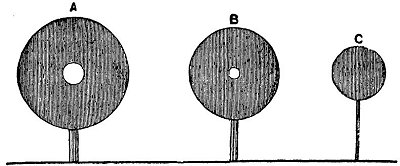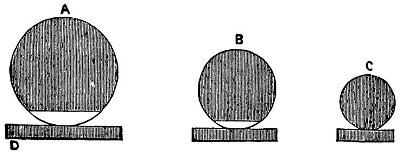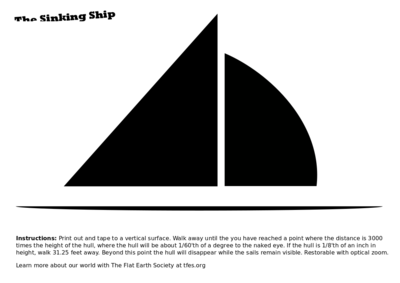Sinking Ship Effect Caused by Limits to Optical Resolution
On the sinking ship, Rowbotham describes a mechanism by which the hull is hidden by the angular limits of perception - the ship will appear to intersect with the vanishing point and become lost to human perception as the hull's increasingly shallow path creates a tangent on which the hull is so close to the surface of the ocean that the two are indistinguishable. The ship's hull gets so close to the surface of the water as it recedes that they appear to merge together. Where bodies get so close together that they appear to merge is called the Vanishing Point. The Vanishing Point is created when the perspective lines are angled less than one minute of a degree. Hence, this effectively places the vanishing point a finite distance away from the observer.
Usually it is taught in art schools that the vanishing point is an infinite distance away from the observer, as so:
However, since man cannot perceive infinity due to human limitations, the perspective lines are modified and placed a finite distance away from the observer as so:
This finite distance to the vanishing point is what allows ships to shrink into horizon and disappear as their hulls intersect with the vanishing point from the bottom up. As the boat recedes into the distance its hull is gradually and perceptively appearing closer and closer to the surface of the sea. At a far off point the hull of the ship is so close to the sea's surface that it is impossible for the observer to tell ocean from hull.
While the sails of the ship may still be visible while the hull is perceptively merged, it's only a matter of time before it too shrinks into the vanishing point which rests on the surface of the sea and becomes indiscernible from the surface.
We know that this explanation is true because the effect is reproducible and there are reports of half sunken ships restored by looking at them through telescopes. It has been found that the sinking ship effect is purely perceptual, that a good telescope with sufficient zoom will change the observer's perspective and bring the ship's hull back in full view. This is not possible if the ship were really behind a "hill of water." Hence, the effect which is usually thought to prove the earth as a globe really proves it to be a plane.
Disk Experiment
In Earth Not a Globe Rowbotham conducts an experiment demonstrating this:
- “

- FIG. 73.
- Let A represent a disc of wood or card-board, say one foot in diameter, and painted black, except one inch diameter in the centre. On taking this disc to about a hundred feet away from an observer at A, the white centre will appear considerably diminished--as shown at B--and on removing it still further the central white will become invisible, the disc will appear as at C, entirely black. Again, if a similar disc is coloured black, except a segment of say one inch in depth at the lower edge, on moving it forward the lower segment will gradually disappear, as shown at A, B, and C, in diagram fig. 74. If the

- Fig. 74.
- disc is allowed to rest on a board D, the effect is still more striking. The disc at C will appear perfectly round--the white segment having disappeared. ”
Zetetic Cosmogony
In the chapter "Disappearance of ships at sea" of the book Zetetic Cosmogony by Thomas Winship we read a number of accounts where the hulls of half sunken ships have been restored by the aid of a telescope:
From Zetetic Cosmogony (external link) by Thomas Winship we read on p.25:
“ When a ship or any other object recedes from the observer on a level surface the highest part is always seen last by reason of perspective. So that the masts and sails of a receding vessel on a flat surface should be seen long after the hull has become invisible to the naked eye. Besides this law of perspective, the hull of a vessel is generally of a dark colour, and often at a very short distance disappears to the naked eye, because it has lost its individuality in the mass of surrounding water, both hull and water being nearly of the same colour. It appears to have mingled with the water, and is thus lost to sight. The hull has no background Whatever, but the masts and sails have a splendid background against the sky, and stand out to advantage, and are, for this reason also, seen long after the hull has vanished. But that the hull has not “ gone down behind a hill of water ” — that it is not because of the globular surface of the water that it is invisible — has been proved by the writer many times.
At Capetown, sometime ago, I made special experiments with a view to arrive at the truth of the matter. On one occasion I watched the schooner Lilla, of Capetown, sail away north, bound to Saldanha Bay. Instead of gradually going down the hill of water—the observer always being on the highest part—she appeared to ascend an inclined plane, until she reached the level of my eye—perhaps 100 feet above sea level—and then gradually diminished in size. Soon her hull disappeared—it was painted black—and her masts and sails became smaller and smaller every minute. I then applied a binocular to the eye, and saw her hull plainly enough. It remained in sight until the individuality of the vessel's parts were lost in the distance.
The iron barque La Quuerida, of Liverpool, sailed out of Table Bay bound to Australia. I watched her until the hull had completely disappeared; but on applying the glass saw it as clearly as possible, and this when the vessel was at least 10 miles away. So that the “hill of water” in both these instances was imaginary only.
In May, 1895, I was a passenger on board the U.S.S. Goth. In Algoa Bay I gave a brief lecture on the subject of this work, and had much discussion with some of the passengers; one affirming he could believe all I said, with the exception of the way I accounted for the disappearance of ships at sea. I replied that we would likely see one of the ships, and then it could be tested. Next day I observed a vessel about ten miles away, but though the masts and sails were pretty clear, the hull was not to be seen. Applying the glass I saw the hull as plain as any other part of the ship. I called the gentleman with whom I had the previous day's conversation and showed him the vessel. I asked him to look at the ship for some time so as to be quite sure whether the hull was visible or not. After looking a minute or so he Was quite certain that the hull could not be seen I asked him why it was invisible. “ Because,” said he, “it is hidden behind a hill of water, the surface of the ocean being convex.” I asked him if he believed my glass could see through a “hill of water,” and gave him the astronomer’s curvature for the distance — which he admitted to be 10 miles — as 10 by 10 by 8 inches = 66 feet, less 20 feet for height of eye and 10 feet for height of the other vessel's hull, = 36 feet the hull should have been below the water. He replied that the glass could not, of course, see through a hill of water, and applied it to his eye. Great was his astonishment on seeing the hull, but equally ready was his confession that the theory of the earth's rotundity founded on the disappearance of ships at sea was false.
On a steamer in March, 1897, when near St. Helena my attention was called to a large vessel, just before sunset. With the naked eye the masts and sails were visible enough, but nothing of the hull could be seen. On applying the glass, there appeared to he no difference, and I was for some time lost in wonder. But as the sun get lower in the heavens, I noticed that the vessel's hull was overshadowed by banks of black clouds low down on the water and thus could not be seen. The hull was enveloped in dense blackness and was lost to the eye. But as soon as the sun was low enough to counteract this effect, I saw the hull quite plain with the glass, when only the sails were visible to the naked eye.
Between Teneriffe and Southampton we sighted a large four-masted steamer astern of us. The hull was also plainly to be seen—the vessel appeared to be in ballast. Our ship's officers said she was 12 miles away, and I think the distance was not less. For two whole days she was visible to us astern ; sometimes the hull being quite plain, at other times being invisible ; thus proving that the state of the atmosphere has more to do with the matter than globularity, if it existed, could have. According to the globe theory, an object plainly visible to the naked eye and seen by scores of people should have been 96 feet below the horizon, allowing both vessels to be the same height above the water, which was as near as possible correct, as our ship had scarcely any cargo on board and presented a high side out of the water.
Another Witness
To the Editor of Earth Review.
Sir, - In August last I, with several other friends, being in Oban for a holiday, took a trip for a day in a small yacht on Loch Lorne, and being a glorious sunshiny day and so calm that not a ripple was seen, and being becalmed for an hour about mid-day we observed a good many sights of various kinds. Amongst other things that we saw was a yacht, which the captain told us was 12 miles distant. We saw all the masts and part of the hull, and to get a better view of her we took our binocular opera glass (a good one). Now, sir, would’nt it require a funny curvature table either with or without the odd fractions to explain how we saw the hull of that vessel twelve miles off? According to a table furnished by the present Astronomer Royal recently, ,it ought to have been 66 feet below the line of sight; but the “table” that we saw it from was the side of our yacht, and we concluded the sea was level.
Yours Respectfully,
John Smith
Saddal, Halifax
The following is from “100 Proofs that the Earth is not a Globe” by William Carpenter:
“If we take a trip down the Chesapeake Bay, in the daytime, we may see for ourselves the utter fallacy of the idea that when a vessel appears “hull down,” as it is called, it is because the hull is “ behind the water” : for, vessels have been seen, and may often be seen again, presenting the appearance spoken of, and away—far away—beyond those vessels, and, at the same moment, the level shore line, with its accompanying complement of tall trees, towering up, in perspective, over the heads of the ‘hull-down’ ships!”
The following is from Chambers’ Journal, of February, 1895, page 32 :
“A good many years ago a Pilot in the Mauritius reported that he had seen a vessel which turned out to be 200 miles off. This incident caused a good deal of discussion in nautical circles at the time, and strange to say, a seemingly well authenticated case of the same kind occurred afterwards at Aden. A Pilot there announced that he had seen from the heights the Bombay steamer then nearly due. He stated precisely the direction in which he saw her, and added that her head was not then turned towards the port. . . . . . Two days afterwards the missing steamer entered the Port, and it was found on enquiries that at the time mentioned by the Pilot she was exactly in the direction and position indicated by him, but ABOUT TWO HUNDRED MILES AWAY.”
Under exceptional conditions of the atmosphere, therefore, enormous distances can be penetrated by the unaided eye, and with a good telescope, objects at distances totally out of proportion to the globular theory, can be seen. Take the case of the above steamer. If the globe theory be correct this vessel would have been FOUR MILES BELOW THE LINE OF SIGHT, allowing one mile for height of the observer, and thus even when aided by the most powerful telescope ever invented, could not have been seen. ”
Cellular Cosmogony
There are also accounts of restored hulls in the book Cellular Cosmogony by Cyrus Teed:
On page 68 to 72 and 73 to 76 we read:
“ The whole of two further targets of dimensions 21×27 and 26×38 inches 7 inches above the water were even seen 5 miles away with the naked eye (the eye was about 30 inches above the water). When the observer lowered their head to 15 inches above the water, the targets became invisible. However, when a telescope was placed even lower, at 6 inches above the water, the targets were plainly visible. ”
“ On August 16 1896 from the Shore of lake Michigan, a very small portion of the top of the masts of a 40-feet high schooner were seen 12 miles away at 30 inches above the water with the naked eye. Opera glasses allowed half the height of the sails to be visible, whereas a 40x telescope enabled the vessel to be seen, including the hull. At 12 miles distant, the bottom of the hull would be 60 feet below the horizon of a convex surface; a clear 20 feet below the top of the mast. ”
Canon PowerShot SX50 HS Zoom Test
A demonstration that lack of optical resolution may hide distant bodies may be found below. In the below video nothing is seen on the horizon by the camera sensor until the optical zoom is used and then the waves and boat become visible.
(Archive)
Home Experiment
Students interested in a home demonstration of the limits to optical resolution may use the material below.




